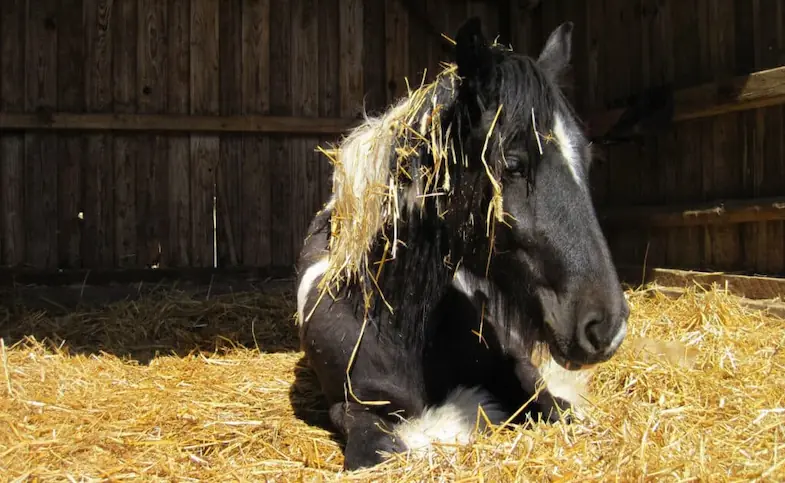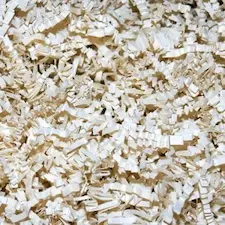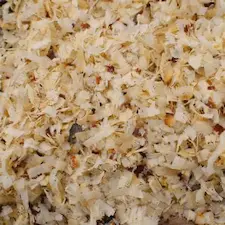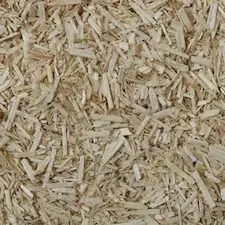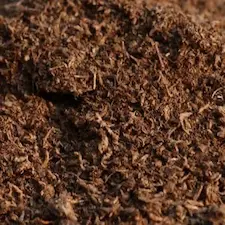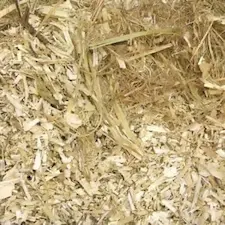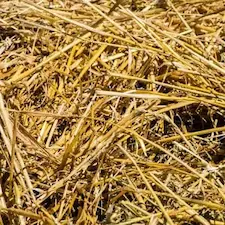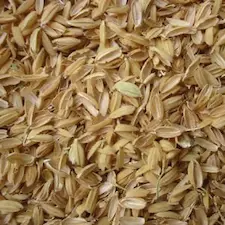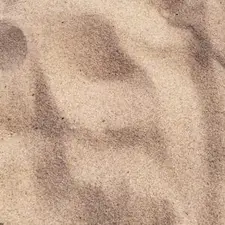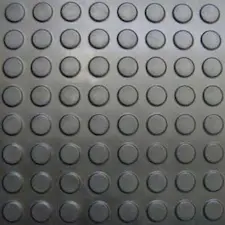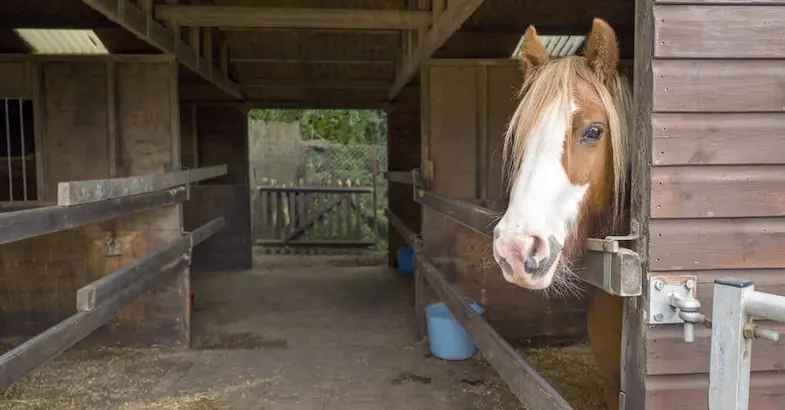Many horse owners, regardless of whether or not their horses have allergies, are moving away from traditional bedding materials such as straw and are turning to alternatives that have a lower level of dust, or even no dust at all. I know from experience that all of these choices, while obviously a good thing, can make it harder to know what’s the best option for your horse which is why I decided to write this article.
What’s the best bedding for horses with allergies? Horses suffering from allergies or respiratory problems will find that flax is the best type of bedding because it’s 100% dust-free, comfortable, and highly absorbent. A close second choice would be peat moss because it has a very low dust content too, but also horses won’t eat it.
We all know that bedding with little or no dust at all is the best thing for horses that are allergy-prone but what you might not realize is that you should also, if possible, opt for a bedding material that’s natural. The reason for this is that many natural materials have their own antibacterial properties that help to maintain the stall’s hygiene and cleanliness. Some manufacturers will use additives in their bedding but even if they’re using natural ingredients it’s still better to use the purest bedding you can. The fewer components it has the better it is for your horse.
Why absorbency is so important when choosing bedding for horses with allergies
When we talk about the best bedding for allergy-prone horses we tend to focus on the dust levels but the ammonia levels can also play an important role which is why absorbency is so important. Unless you clean your horse’s stall immediately after they’ve urinated a certain amount of ammonia will build up. In small amounts, and in a well-ventilated stall, this isn’t a problem but, if your horse is exposed to ammonia over a long period of time it can cause respiratory problems and make any allergies worse, after all, ammonia is a corrosive substance.
This is why the absorbency of your horse’s bedding is so important but it can be difficult to find just how absorbent different materials are. I had a tough time finding this out online so decided to buy a variety of bedding types and test their absorbency levels myself. While the results below aren’t conclusive it does give you an idea of how much water (or urine) each type of bedding can hold.
| Type of horse bedding | Amount of water absorbed per 100g |
|---|---|
| Cardboard | 469ml |
| Oil Seed Rape Straw | 419ml |
| Flax | 369ml |
| Miscanthus Straw | 369ml |
| Wood Pellets | 319ml |
| Hemp | 249ml |
| Sawdust | 249ml |
| Shells | 249ml |
| Straw | 249ml |
| Wood Flakes | 249ml |
| Wood Shavings | 249ml |
| Peat Moss | 219ml |
| Treated Straw | 219ml |
| Shredded Paper | 159ml |
| Wood Chip/Fibre | 149ml |
| Sand | 40ml |
| Rubber Matting | 0ml |
If you’re preferred bedding isn’t that absorbent you can use zeolite granules (or powder) to neutralize the ammonia and help your horse’s stall smell fresh. I’ve tried a few different zeolite products but have found Manna Pro’s PDZ horse stall refresher the best on the market. I always buy it from Amazon because they’ve always been the cheapest.
What’s the best bedding for horses with allergies?
Gone are the days when the only two choices we had were straw or, if your horse had an allergy, wood shavings. While they are both still used today (and are still very popular) the market has expanded immensely which is great for you and your horse, but in some cases, it’s also beneficial to the environment. The only drawback to all of this choice though is that it can be difficult to know what’s what and what the best option is for your horse.
Paper
I know that paper may not be your first choice when you’re looking for bedding for your horse but when you realize how good it is you may well change to it forever. Not only is it cheap and super absorbent but it’s also generally a byproduct of the manufacturing process which means it’s good for the environment too. Paper bedding is available in shredded form or as cardboard.
Shredder paper – Shredded paper bedding has the same insulating properties as straw or wood shavings but is 100% dust-free which is great for allergy-prone horses. It’s also pretty absorbent but when it gets wet it can start to clump together which, while making it easier to clean, can leave bare patches on the floor that can become uncomfortable for your horse. Another disadvantage of shredded paper though is that when it gets wet some of the dye can come off and stain your horse’s coat, especially if it’s a light color.
Cardboard – An alternative to shredded paper, cardboard is 100% dust-free so is absolutely perfect for horses with allergies as well as those with respiratory problems. Cardboard bedding is typically made from the waste that’s leftover from factories that make cardboard boxes (I know I didn’t think about where they were made either). Like shredded paper, it’s also very warm (which is one of the reasons why some people use it during the winter) but unlike paper, it won’t stain your horse’s coat.
Pros of paper bedding
- Very absorbent
- Unpalatable to horses
Cons of paper bedding
- Harder to keep clean
- Can be blown away (even on the muck heap)
Wood
For many years wood bedding (whether it be shavings, chipping, flakes or pellets) has been a great alternative to straw bedding, being especially popular with owners of horses with respiratory issues or those that like to eat straw. Depending on how fine the bedding (and how deeply it’s been laid) is it can also help to support the horse’s hooves and prevent injuries such as capped hocks or elbows.
Like paper, wood bedding is available in a number of different forms.
Wood flakes – Normally made from softwood, wood flakes offer a very comfortable bed for your horse while also being extremely absorbent (they’re actually more absorbent than shredder paper). Since most flakes are made from coniferous wood, they smell nice and are generally pathogen-free which is ideal for allergy-prone horses.
Wood pellets – Often made by compressing sawdust into pellets that are then heat-treated, pellets are low in dust and, due to the way they’re made, are free of mold, spore, bacteria, and other pathogens, making it a hygienic choice. Due to their compact nature, wood pellets are normally shipped in bags which can make them easier to carry but this ‘compactness’ means that they need to be wetted before use, in order to allow them to fluff up to their full size.
Wood shavings – Probably the most popular form popular wood bedding, wood shavings can be bought in smaller bags or by the truckload which means that it can be very cost-effective, especially if you have a lot of horses. Its absorbency varies depending on the size of the shavings (they can range from just 1mm to around 40mm) and the amount of dust is largely dependant on the quantity you buy (the smaller the quantity the lower the dust).
Wood chip/fiber – Made from shredded wood fiber, it’s similar to wood shavings in that it’s widely available and reasonably priced. It contains slightly more dust than wood shavings and isn’t as absorbent, but one advantage it does have over shavings though is that because the pieces are a lot smaller they won’t cling to your horse’s mane or tail, this means that there’s less waste and you don’t have to spend so long grooming. While it’s not massively absorbent it will keep your horse dry because the urine will immediately run to the bottom, leaving the top layer dry for your horse.
Wood sawdust – While a lot of people like to use sawdust bedding and highly recommended it but, in my opinion at least, I’m not a fan. I can appreciate its cheap, comfortable, and absorbent but I also think that it can be very dusty and on very rare occasions there can also be sharper pieces of wood.
Regardless of what type of wood bedding you opt for there’s also a choice of wood, each with their own benefits.
Pine – At the premium end of the market, pine has natural antibacterial properties that can be really helpful if your horse has any cuts or scrapes. Pine also has a lot of natural oil that can help to condition your horse’s coat when they lie on it.
Kiln-dried – General timber wood is often kiln-dried to remove any excess dust but this process has the added benefit of the wood being able to naturally control any odors.
Cedar – Some people like to use cedar wood because it smells nice, but you have to be careful because it can cause allergies in some horses. Another drawback to cedar wood is that it can pull too much moisture from a horse’s hooves, especially the horn.
IMPORTANT: If you choose to use wood bedding then it’s crucial you make sure it’s suitable for horses and doesn’t contain any black walnut wood. This can cause laminitis in horses that stand on it, even for a short period of time.
Pros of wood bedding
- Absorbent
- Most people sell it
Cons of wood bedding
- Can be dusty
- Prices vary wildly
Hemp
You might not realize it but hemp is actually one of the best bedding types on the market today, made from the soft inner core of the hemp stalk it’s actually a byproduct of the fashion industry which uses the tougher outer stalk. Hemp bedding is environmentally friendly because it’s recycled and biodegradable but it’s also very low in dust and extremely absorbent (only cardboard is more absorbent).
Pros of hemp bedding
- Environmentally friendly
- Amongst the most absorbent bedding
Cons of hemp bedding
- Not so easy to get hold of
- Can be expensive
Peat moss
A relatively new form of bedding material, peat moss is a particular type of moss that’s formed when dead, fibrous plant materials decomposes in marshy bogs. By its very nature peat moss is extremely absorbent and also lasts a long time, as an added bonus horses generally don’t like the taste either. Peat moss makes a soft and comfortable bedding but it can be difficult to clean because it’s dark in color which makes it harder to see the manure (although it can be good because your stall always looks clean – even when it’s not ????). The main drawback to peat moss is that it can often be difficult to find a supplier, something that sadly pushes the price up too.
Some people believe that the way peat moss is extracted is bad for the environment which has led some countries to start to phase out the extraction of the moss, this has meant that the price is even higher in those countries.
Pros of peat moss bedding
- Horses don’t like the taste
- Highly absorbent
Cons of peat moss bedding
- Difficult to find a supplier
- Not easy to clean
Flax
Almost as absorbent as peat moss, flax is much more widely available due to the fact that it’s a byproduct of the flax fiber process that’s used in a variety of industries such as loose-fill insulation and linen production. Many horse owners (or at least those with allergy-prone horses) love flax because it’s completely dust-free and is as soft as down. It’s also good for horses that have hoof problems because it’s incredibly soft, even without a thick layer. The only downside to flax though is that it can get a little slippery when it gets wet.
Pros of flax bedding
- 100% dust-free
- Will biodegrade quickly
- Lasts around 2 – 3 times as long as straw
Cons of flax bedding
- Can get slippery if its wet
Straw
I know you’ll probably say that straw is the worst bedding for allergy-prone horses and yes that is true but I’m not talking about ‘regular’ wheat or oat straw I’m talking about treated straw and particular straws such as miscanthus and oil seed rape. They all have special properties (or added ingredients) that help to reduce the dust levels and make them suitable for all horses.
Miscanthus straw – Also known as elephant grass, it’s made by finely chopping the stalks of miscanthus plant which is a type of grass. It’s a popular choice because not only is it dust-free but it’s also free of chemicals and additives. Miscanthus bedding is also a carbon-negative crop because it absorbs more C02 than it releases which makes it great for the climate as well as for our horses.
Oil seed rape straw – Being completely dust-free, oil seed rape is perfect for horses with respiratory problems. Some manufacturers will also add natural herb extracts to the straw which act as a disinfectant but also help to reduce the ammonia levels, others may add lemon-scented tea tree oil because it helps to deodorize the stall and acts as an insect repellant.
Treated straw – Typically made from wheat, treated bedding is very finely chopped but is also treated so that it’s not as dusty and isn’t so palatable for horses. While the treating process doesn’t completely remove all of the dust it does reduce it quite considerably, certainly enough to make it suitable for horses with mild allergies.
Pros of straw bedding
- Available from most bedding suppliers
- Probably the cheapest of all beddings
Cons of straw bedding
- A lot of horses eat straw bedding
- Prone to mold if not stored properly
Shells
It never ceases to amaze me how ingenious some manufacturers can be and shell bedding is a great example of this. When many crops are de-shelled (or de-husked or de-hulled depending on the food item) the waste is often turned into soft bedding (they can also be ground down and used to feed many grazing animals). Both rice hulls and peanut husks are extremely popular but some horses will eat them though.
Pros of shell bedding
- Keeps horses dry
- Very low dust levels
Cons of shell bedding
- Some horses will eat the shells
- Not very absorbent
Sand
Rather than using sand as the main bedding, some people choose to use it as an underlayer instead and then put some other form of bedding on top of it. The reason for this is that not only is sand not very absorbent but it can also cause digestive problems such as colic if too much is eaten. That said though, it can be very soft and is probably the easiest bedding to clean because the sand just falls through the fork.
IMPORTANT: If you do use sand bedding, even if it’s only for the under layer then you should feed your horse in a bucket, rack, or net. This will keep the food off of the floor and reduce the chance of your horse ingesting the sand.
Pros of sand bedding
- Super easy to clean
- Virtually no wastage at all
Cons of sand bedding
- Can cause digestive issues eaten
- Can make a horse’s coat gritty
Matting
While you can use matting on its own it should ideally be used underneath a removable layer of bedding such as any of the ones mentioned above. Normally made of rubber, mats offer a soft, dust-free covering to the floor of your stall which can make cleaning it much quicker (and cheaper in the long run). The problem with matting though is that it’s not absorbent at all so can become slippery if you don’t use a top layer of bedding. The initial cost of having the mats installed can also put owners off.
Pros of matting bedding
- Easy to clean
- No dust at all
Cons of matting bedding
- Expensive to install
- Can be slippery
How much does horse bedding cost?
The price of bedding can vary throughout the year, depending on the seasons and how good (or bad) harvests have been, but the table below will give you a good idea of what you can expect to pay for different bedding materials.
| Type of Bedding | Cost | Quantity per 12 x 12 stall |
| Cardboard | $21.95 per bag | 1.5 bags |
| Shredded Paper | $10.95 per bag | 2 bags |
| Wood Flakes | $26.50 per bag | 1.5 bags |
| Wood Pellets | $5.99 per bag | 3 bags |
| Wood Shavings | $6.99 per bag | 3 bags |
| Wood Chip/Fibre | $26.50 per bale | 1 bale |
| Sawdust | $25 per bag | 2.5 bags |
| Hemp | $20.99 per bag | 1.5 bags |
| Peat Moss | $10.00 per bale | 1 bale |
| Flax | $6.50 per bag | 0.75 bags |
| Miscanthus Straw | $23.50 per bale | 1 bales |
| Oil Seed Rape Straw | $20.00 per bale | 1 bale |
| Treated Straw | $20.00 per bale | 1 bale |
| Straw | $6.99 per bale | 1 bale |
| Shells | $9.99 per bag | 2 bags |
| Rubber Matting | $2 per mat (one off cost) | 144 mats |
| Sand | $9.95 per metric ton | 0.1 ton |
Related questions
What causes allergies in horses?
Most veterinarians agree that dust particles and microscopic spores are the number one reason for allergies with horses. These allergies normally manifest in the form of respiratory issues but the odor from ammonia (that comes from the urine) can also cause allergies.
How often should you change your horse’s bedding?
As a rule, you should clean the urine and manure out of your horse’s stall every day, top the bedding up (if necessary) every day, and then fully clean the stall and change the bedding every week. This will help to keep the stall clean and reduce the build-up of harmful chemicals such as ammonia.
I hope you found this article helpful. If you did I’d be grateful if you could share it please as it would really help me.
Recommended products
Over the years I have tried hundreds of different horsey products, from various blankets and halters to different treats. Some I’ve loved, others I’ve hated but I thought I’d share with you my top all-time favorite products, the ones I never leave the yard without. I’ve included links to the products (which are in no particular order) that I really think are great.
- Horse Knots by Reference Ready – If you’re like me and enjoy pocket reference guides then you’ll love this knot tying guide. These handy cards can easily fit in your pocket or attach to the saddle for quick reference. They’re waterproof, durable and are color coded to make them easy to follow.
- Mane ’n Tail Detangler – Even if you never show your horse you’ll need to detangle his tail from time to time (and possibly his mane too) which is always a challenging chore! I’ve found that if I run a little bit of detangler through my horse’s tails every few days it stops them from getting matted up and makes combing them easy, even if they’re coated in mud. I don’t know if I should admit to this or not but it also works wonders on my hair.
- TAKEKIT Pro clippers – Over the years I’ve tried a lot of different clippers and while some were obviously better than others I found these to be by far the best. They are heavier than a lot of other clippers but for me, that’s a good thing, it makes them feel more sturdy and hardwearing. On top of that they have a range of speeds so are just as good for clipping your horse’s back as they are his face. I also like the fact that they come in a handy carry case but that’s not for everybody. The company that makes them is super good and incredibly helpful too, a real bonus these days. The only thing I wasn’t keen on was the fact that it doesn’t come with any oil, but that’s not a major problem as it’s not difficult to buy lubricant.
- Shire’s ball feeder – There are so many boredom buster toys out there but I like to use these every day, regardless of whether or not my horses are bored. I find that it helps to encourage my horses to problem solve by rewarding them with treats (or pieces of fruit) but it also mimics their natural grazing behavior which helps to keep them calm and de-stressed.
- Horse safe mirror – This is a strange one that many people are surprised about but I like to put horse safe mirrors in the trailers as well as in the quarantine stalls. It helps to prevent the feeling of isolation by giving the impression of other horses being around. Being herd animals horses can get extremely stressed when they feel that they’re on their own but with these stick-on mirrors, they believe that at least one other horse is with them.
- Rectal thermometer – I know this isn’t glamourous at all but it’s vital for your horse’s well-being to be able to check their temperature and a rectal thermometer is the easiest way of doing this which is why I’ve added it to the list.
Shopping lists
I’ve also put together a few shopping lists of essential items that I’ve found helpful over the years. I’ve broken the lists down into different categories rather than put everything in one massive list 😉

